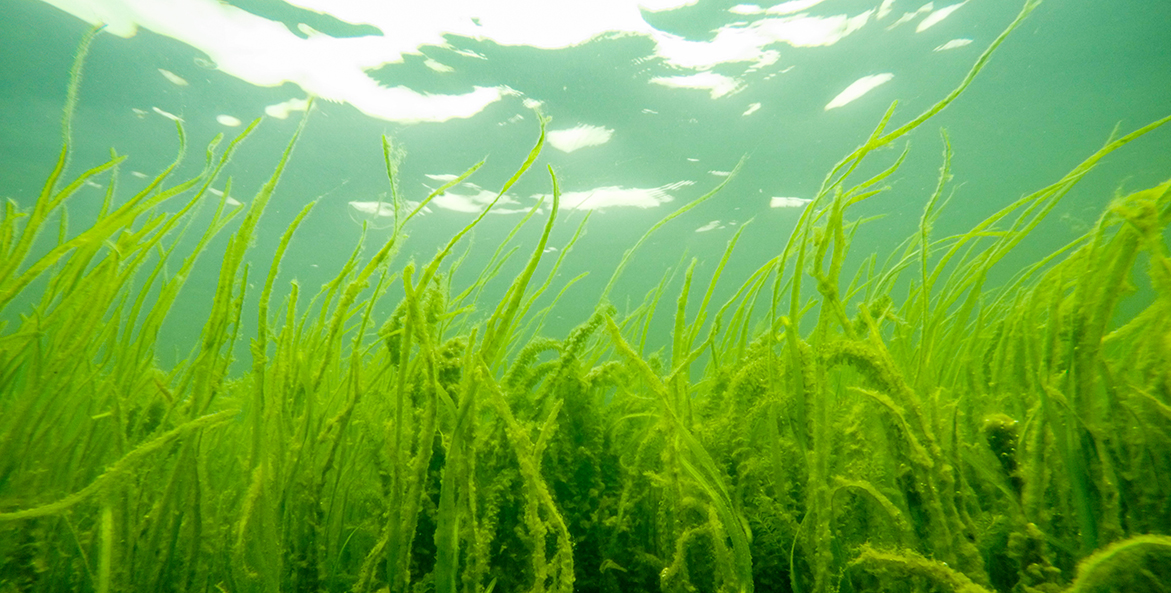Underwater grasses are a critical habitat in the Bay and its tidal rivers. We asked Beth McGee, CBF’s Director of Science and Agricultural Policy, for an update on their latest status and what it means for the health of the Bay.
What are underwater grasses and why are they important for the Bay?
There are more than a dozen types of underwater grasses that grow in the Chesapeake Bay and its rivers, typically in shallow water. They’re an extremely important habitat because they provide shelter and food for juvenile fish, crabs, migrating water birds, and other species of wildlife. They’re also important for protecting shorelines from erosion, improving water clarity, and can even help reduce the effects of climate change. For example, a recent study demonstrated that underwater grasses help diminish the acidification of the Bay caused in part by the burning of fossil fuels, which threatens the health of fish and shellfish. The study showed that Bay grasses can act as a ‘Tums’ to help alleviate acidification.
What does the latest survey tell us about the state of grasses in the Bay?
In July, the Chesapeake Bay Program released its assessment of the extent of underwater grasses in the Bay, based on surveys completed in 2019. It found a 38 percent decline in grass acreage between 2018 and 2019. The biggest declines were seen in the Tangier Sound area, mostly because of losses of widgeon grass—a species that appears sensitive to extreme weather and changes in water quality. However, the survey also showed areas where grass beds actually expanded, for example in the Severn and Magothy rivers in Maryland, and in parts of the Rappahannock, James, and Chickahominy rivers in Virginia.
How are grasses doing over the long term, and how does this year’s survey fit into that trend?
The decline follows a period of recovery for Bay grasses. Previously, in 2017, underwater grass beds reached their largest extent in 40 years, covering more than 100,000 acres of the Bay. Researchers estimate they also surpassed 100,000 acres in 2018, though the survey was incomplete due to weather challenges. And despite the losses, 2019’s grass coverage was still a 70 percent increase from the first grass survey conducted in 1984.
What does the drop in grass acreage mean for the health of the Bay?
The loss of underwater grasses last year is a reminder that the Chesapeake Bay is still a system that’s dangerously out of balance. The exact cause of the decline is unknown, but the Bay Program pointed to record-breaking river flows as one potential factor. High flows of fresh water wash more pollution into the Bay, affecting water clarity and blocking sunlight that grasses need to survive. It’s also an example of how climate change is threatening the Bay’s recovery—grasses are vulnerable to both extreme flows of fresh water and warming temperatures that are linked to climate change.
How can we help underwater grasses rebound?
We can’t control the weather, but we can help grasses by reducing the amount of pollution washing into the Bay and its rivers. Fully implementing the Chesapeake Clean Water Blueprint by 2025 is critical. Many of the pollution-reduction strategies called for in the Blueprint, including planting forested buffers and implementing air pollution controls on power plants, have dual benefits for reducing pollution to local waters while also reducing greenhouse gas emissions that contribute to climate change. But if we’re going to meet the Blueprint goals, the states need to accelerate their efforts to reduce pollution, and the U.S. Environmental Protection Agency needs to hold them accountable to their commitments.



